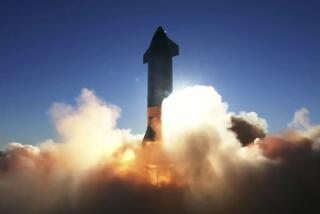Launch of the Shuttle Discovery : No Aid in Challenger-Type Blast : Escape System Designed to Be Used if Engines Fail
- Share via
KENNEDY SPACE CENTER, Fla. — The crew of the space shuttle Discovery is outfitted with something no other shuttle crew has had--a parachute escape system that might save their lives in the event of multiple engine failure.
Created in response to the Challenger explosion on Jan. 28, 1986, the system would give the astronauts a way out of a doomed spaceship, but only under certain conditions.
The escape system on Discovery would be of no use in a solid-fueled rocket failure like the one that destroyed Challenger. Further, the shuttle would have to be in controlled subsonic gliding flight for the crew to parachute out safely.
‘High-Tech’ Machines
“I’m glad we have this capability because . . . these shuttle main engines are some very high-tech, very complicated machines that operate at very high energy,” said Frederick H. Hauck, Discovery commander and veteran of two other shuttle missions.
“If something were to go wrong with one of those that took out another one . . . then this escape system we have would be our only hope to survive.”
While there are no survivable abort options for rocket booster failures, the space shuttle was designed to withstand the failure of one of its three main engines--at any time--by making an emergency landing at the Kennedy Space Center, in Europe or in Africa.
But during the early phases of flight, two or more engine failures would leave the shuttle without enough power to make a runway. In that case, the crew would have to “ditch” the orbiter in the ocean--but since shuttles land at more than 200 m.p.h., ditching is not considered survivable.
In the wake of the Challenger explosion, the National Aeronautics and Space Administration examined several possible escape systems ranging from ejection seats to simply jumping out the side hatch for a parachute descent.
System Has 3 Elements
The agency decided on a bail-out system with three main elements: a side hatch that can be blown out, spacesuits equipped with parachutes and survival gear and an 8 3/4-foot telescoping pole to guide the parachuting astronauts away from the shuttle’s wing.
“This is a controlled, gliding flight escape system,” said Steven R. Nagel, an astronaut who participated in the development of the bail-out system.
To operate the system, an astronaut seated on the shuttle’s lower deck--George D. Nelson for Discovery’s flight--would pull a handle that would open a vent at an altitude of about 40,000 feet to let cabin air pressure equalize at around 30,000 feet.
The commander then would orient the shuttle so that its rate of descent was just right to maintain the proper airspeed of between 213 and 224 m.p.h. He then would put the shuttle on autopilot and climb down to the lower deck.
At somewhere from 20,000 to 30,000 feet, and on the commander’s decision, the side hatch would be jettisoned, the telescoping pole would extend through the open hatch and the crew would begin to bail out.
“Each crew member in turn would connect (a) ring on his or her parachute harness to a lanyard on the pole and then just roll out,” Nagel said.
Tested for Clearance
Tests by a Navy parachute team and wind tunnel studies showed an astronaut would clear the shuttle’s left wing by about 18 feet.
Practice sessions on the ground showed a crew of five would need about two minutes to get out.
To go along with the system, shuttle crews now will take off and land wearing bulky orange spacesuits capable of keeping them alive at altitudes up to 100,000 feet. The 70-pound suits feature a built-in life preserver and air supply with backpacks housing the parachute and a small life raft.
“As the crew member rides down the pole, the parachute is armed,” Nagel said. “Three seconds after going down the pole, the parachute begins to open.”
More to Read
Sign up for Essential California
The most important California stories and recommendations in your inbox every morning.
You may occasionally receive promotional content from the Los Angeles Times.










